Business Analysis Body of Knowledge (BABOK) Report
VerifiedAdded on 2020/04/15
|15
|2877
|30
Report
AI Summary
This report provides a comprehensive analysis of the Business Analysis Body of Knowledge (BABOK), covering core concepts, business analysis planning and monitoring, the McKinsey 7-S framework, solution assessment and validation, and requirement analysis. The report delves into the core concept model of elicitation and collaboration, outlining the six key objectives of change, need, solution, stakeholder, value, and context. It then examines the tasks involved in business analysis planning and monitoring, including change, need, solution, stakeholder, value, and context, along with their inputs and outputs. The report further explores the McKinsey 7-S framework, dividing its elements into hard and soft categories, and highlighting its applicability to organizational effectiveness. Solution assessment and validation tasks are discussed, emphasizing the importance of change, need, solution, stakeholder, value, and context in evaluating the solution's performance. The report also details the tasks involved in requirement analysis, such as verifying, specifying, modeling, and validating requirements, along with defining solution options and requirements architecture. Finally, the report provides an example of eliciting requirements for a webpage project, differentiating between user and system requirements, and outlining the process of requirement elicitation. The report provides a valuable resource for students and professionals seeking to understand and apply the principles of business analysis.
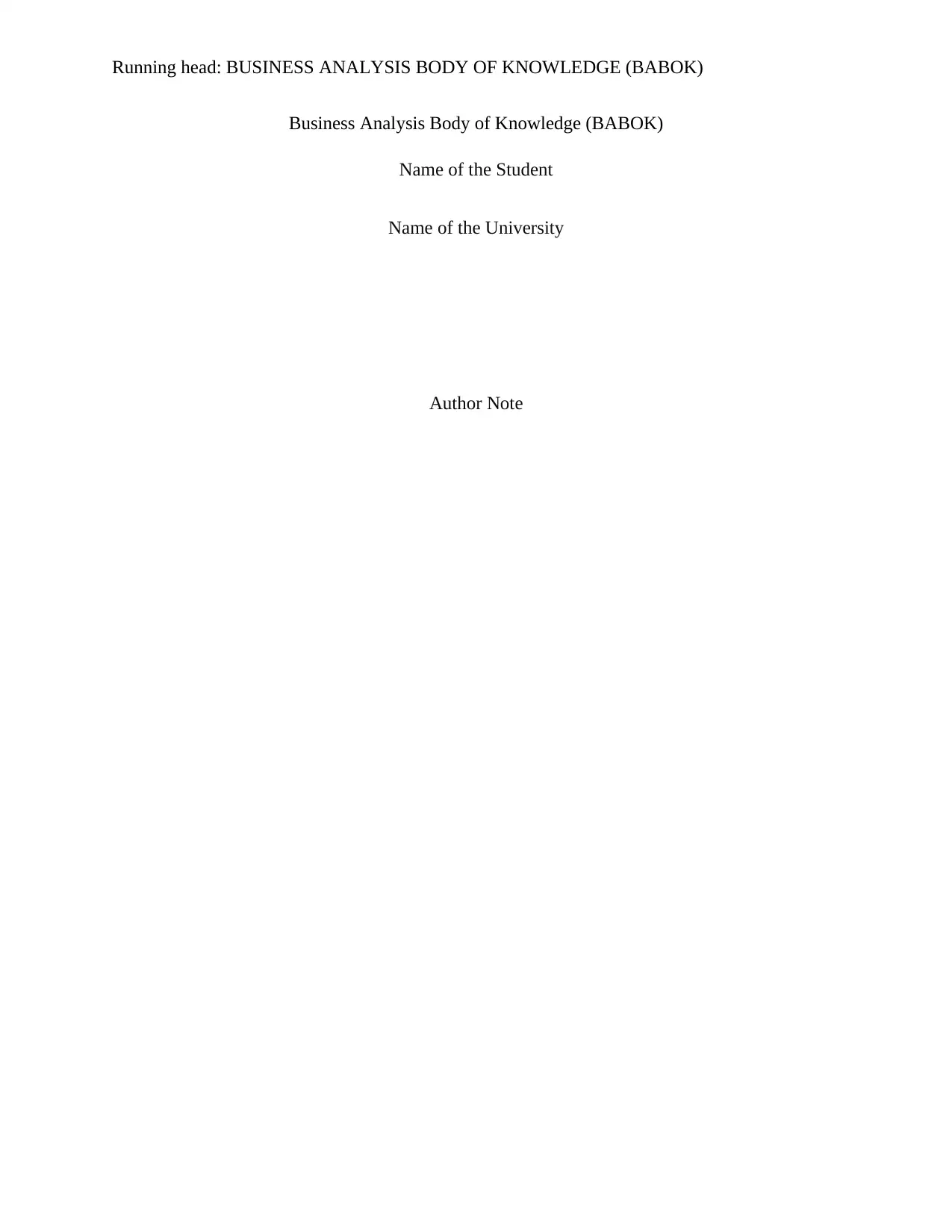
Running head: BUSINESS ANALYSIS BODY OF KNOWLEDGE (BABOK)
Business Analysis Body of Knowledge (BABOK)
Name of the Student
Name of the University
Author Note
Business Analysis Body of Knowledge (BABOK)
Name of the Student
Name of the University
Author Note
Paraphrase This Document
Need a fresh take? Get an instant paraphrase of this document with our AI Paraphraser
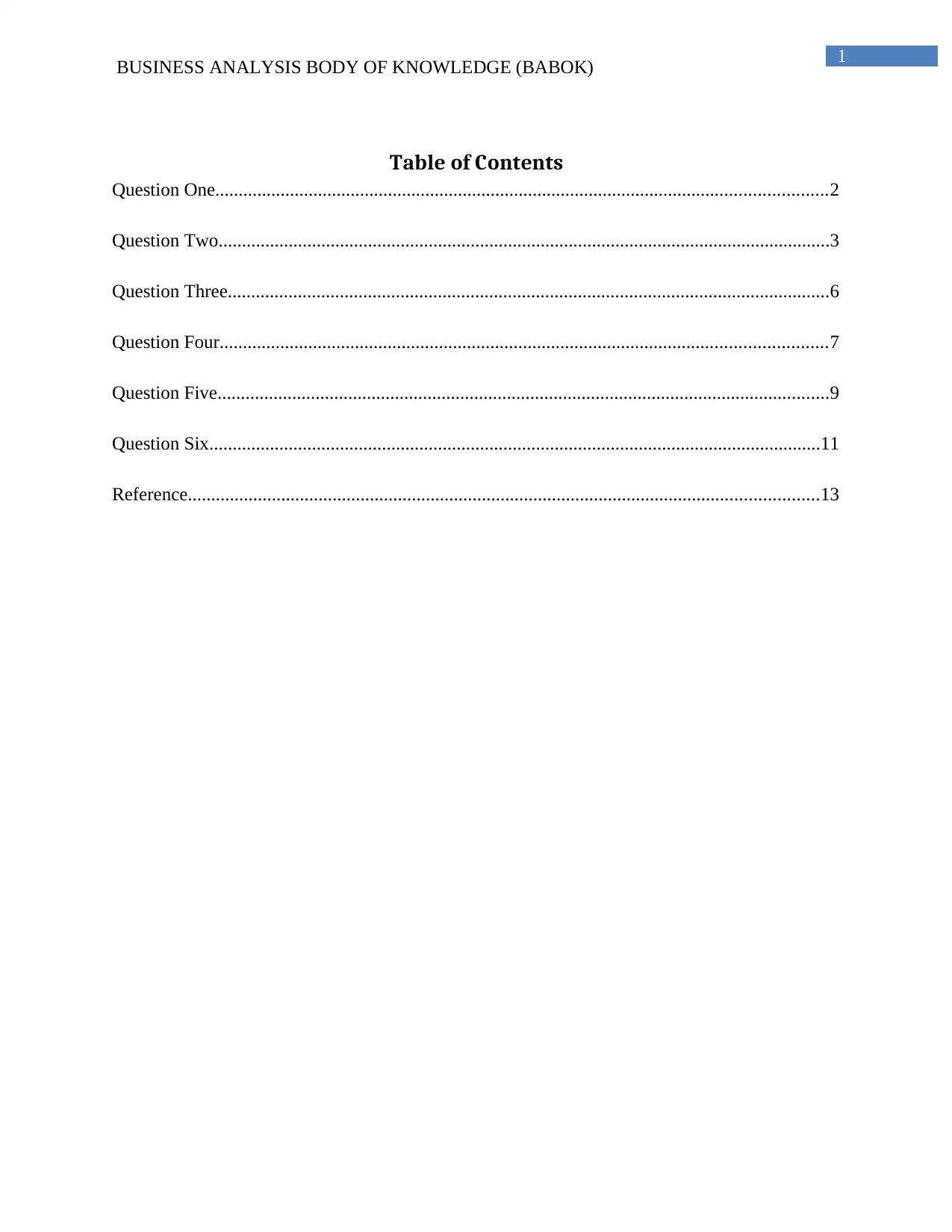
1
BUSINESS ANALYSIS BODY OF KNOWLEDGE (BABOK)
Table of Contents
Question One...................................................................................................................................2
Question Two...................................................................................................................................3
Question Three.................................................................................................................................6
Question Four..................................................................................................................................7
Question Five...................................................................................................................................9
Question Six...................................................................................................................................11
Reference.......................................................................................................................................13
BUSINESS ANALYSIS BODY OF KNOWLEDGE (BABOK)
Table of Contents
Question One...................................................................................................................................2
Question Two...................................................................................................................................3
Question Three.................................................................................................................................6
Question Four..................................................................................................................................7
Question Five...................................................................................................................................9
Question Six...................................................................................................................................11
Reference.......................................................................................................................................13
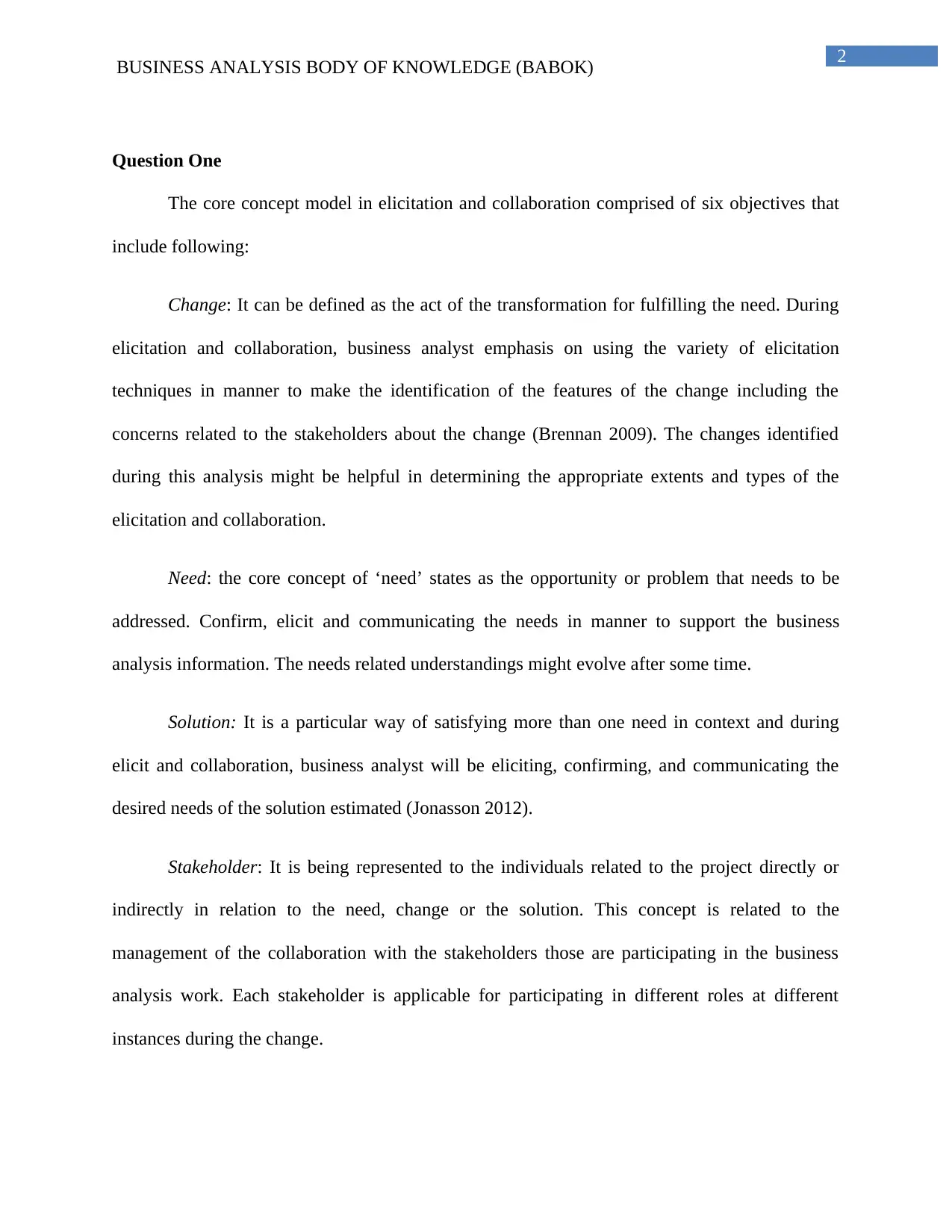
2
BUSINESS ANALYSIS BODY OF KNOWLEDGE (BABOK)
Question One
The core concept model in elicitation and collaboration comprised of six objectives that
include following:
Change: It can be defined as the act of the transformation for fulfilling the need. During
elicitation and collaboration, business analyst emphasis on using the variety of elicitation
techniques in manner to make the identification of the features of the change including the
concerns related to the stakeholders about the change (Brennan 2009). The changes identified
during this analysis might be helpful in determining the appropriate extents and types of the
elicitation and collaboration.
Need: the core concept of ‘need’ states as the opportunity or problem that needs to be
addressed. Confirm, elicit and communicating the needs in manner to support the business
analysis information. The needs related understandings might evolve after some time.
Solution: It is a particular way of satisfying more than one need in context and during
elicit and collaboration, business analyst will be eliciting, confirming, and communicating the
desired needs of the solution estimated (Jonasson 2012).
Stakeholder: It is being represented to the individuals related to the project directly or
indirectly in relation to the need, change or the solution. This concept is related to the
management of the collaboration with the stakeholders those are participating in the business
analysis work. Each stakeholder is applicable for participating in different roles at different
instances during the change.
BUSINESS ANALYSIS BODY OF KNOWLEDGE (BABOK)
Question One
The core concept model in elicitation and collaboration comprised of six objectives that
include following:
Change: It can be defined as the act of the transformation for fulfilling the need. During
elicitation and collaboration, business analyst emphasis on using the variety of elicitation
techniques in manner to make the identification of the features of the change including the
concerns related to the stakeholders about the change (Brennan 2009). The changes identified
during this analysis might be helpful in determining the appropriate extents and types of the
elicitation and collaboration.
Need: the core concept of ‘need’ states as the opportunity or problem that needs to be
addressed. Confirm, elicit and communicating the needs in manner to support the business
analysis information. The needs related understandings might evolve after some time.
Solution: It is a particular way of satisfying more than one need in context and during
elicit and collaboration, business analyst will be eliciting, confirming, and communicating the
desired needs of the solution estimated (Jonasson 2012).
Stakeholder: It is being represented to the individuals related to the project directly or
indirectly in relation to the need, change or the solution. This concept is related to the
management of the collaboration with the stakeholders those are participating in the business
analysis work. Each stakeholder is applicable for participating in different roles at different
instances during the change.
⊘ This is a preview!⊘
Do you want full access?
Subscribe today to unlock all pages.

Trusted by 1+ million students worldwide
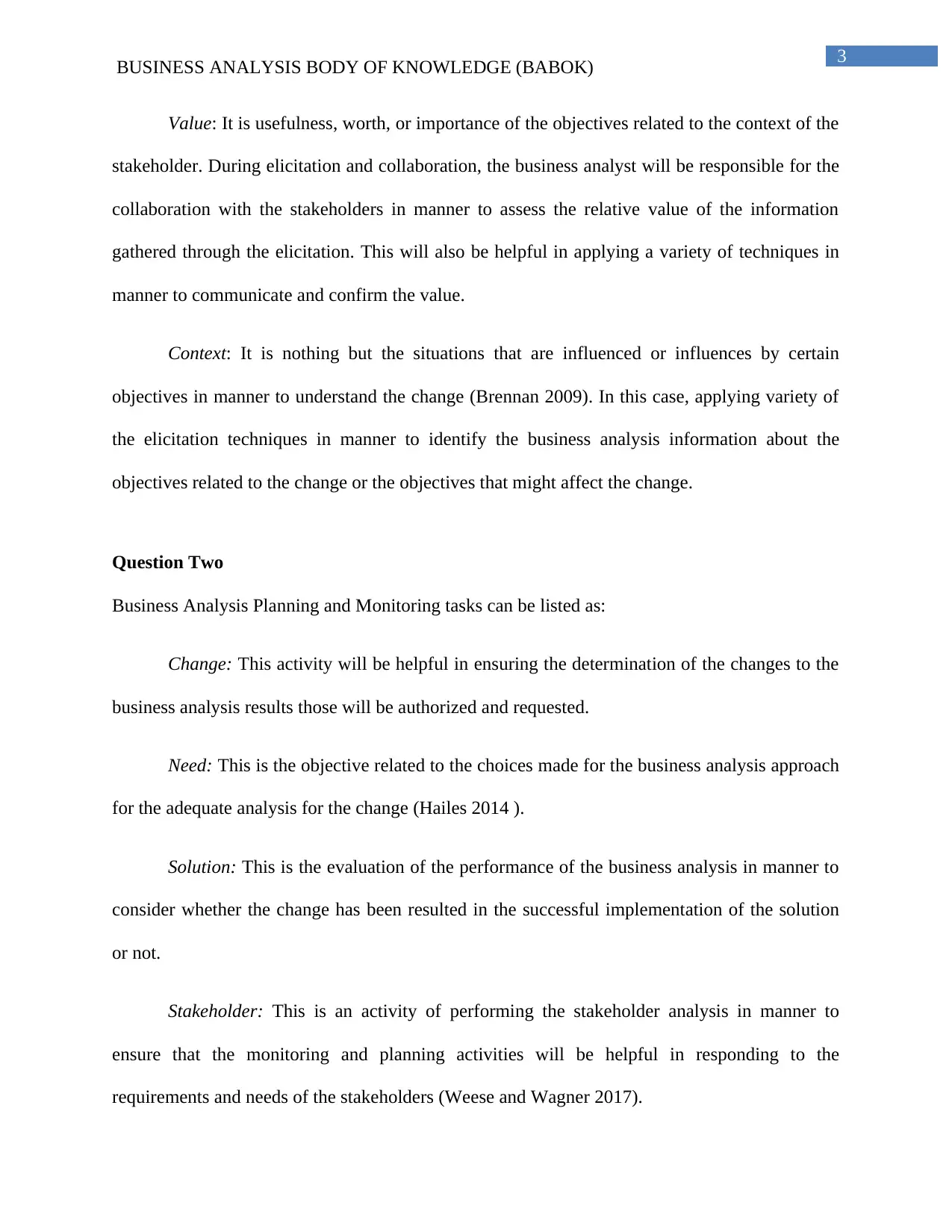
3
BUSINESS ANALYSIS BODY OF KNOWLEDGE (BABOK)
Value: It is usefulness, worth, or importance of the objectives related to the context of the
stakeholder. During elicitation and collaboration, the business analyst will be responsible for the
collaboration with the stakeholders in manner to assess the relative value of the information
gathered through the elicitation. This will also be helpful in applying a variety of techniques in
manner to communicate and confirm the value.
Context: It is nothing but the situations that are influenced or influences by certain
objectives in manner to understand the change (Brennan 2009). In this case, applying variety of
the elicitation techniques in manner to identify the business analysis information about the
objectives related to the change or the objectives that might affect the change.
Question Two
Business Analysis Planning and Monitoring tasks can be listed as:
Change: This activity will be helpful in ensuring the determination of the changes to the
business analysis results those will be authorized and requested.
Need: This is the objective related to the choices made for the business analysis approach
for the adequate analysis for the change (Hailes 2014 ).
Solution: This is the evaluation of the performance of the business analysis in manner to
consider whether the change has been resulted in the successful implementation of the solution
or not.
Stakeholder: This is an activity of performing the stakeholder analysis in manner to
ensure that the monitoring and planning activities will be helpful in responding to the
requirements and needs of the stakeholders (Weese and Wagner 2017).
BUSINESS ANALYSIS BODY OF KNOWLEDGE (BABOK)
Value: It is usefulness, worth, or importance of the objectives related to the context of the
stakeholder. During elicitation and collaboration, the business analyst will be responsible for the
collaboration with the stakeholders in manner to assess the relative value of the information
gathered through the elicitation. This will also be helpful in applying a variety of techniques in
manner to communicate and confirm the value.
Context: It is nothing but the situations that are influenced or influences by certain
objectives in manner to understand the change (Brennan 2009). In this case, applying variety of
the elicitation techniques in manner to identify the business analysis information about the
objectives related to the change or the objectives that might affect the change.
Question Two
Business Analysis Planning and Monitoring tasks can be listed as:
Change: This activity will be helpful in ensuring the determination of the changes to the
business analysis results those will be authorized and requested.
Need: This is the objective related to the choices made for the business analysis approach
for the adequate analysis for the change (Hailes 2014 ).
Solution: This is the evaluation of the performance of the business analysis in manner to
consider whether the change has been resulted in the successful implementation of the solution
or not.
Stakeholder: This is an activity of performing the stakeholder analysis in manner to
ensure that the monitoring and planning activities will be helpful in responding to the
requirements and needs of the stakeholders (Weese and Wagner 2017).
Paraphrase This Document
Need a fresh take? Get an instant paraphrase of this document with our AI Paraphraser
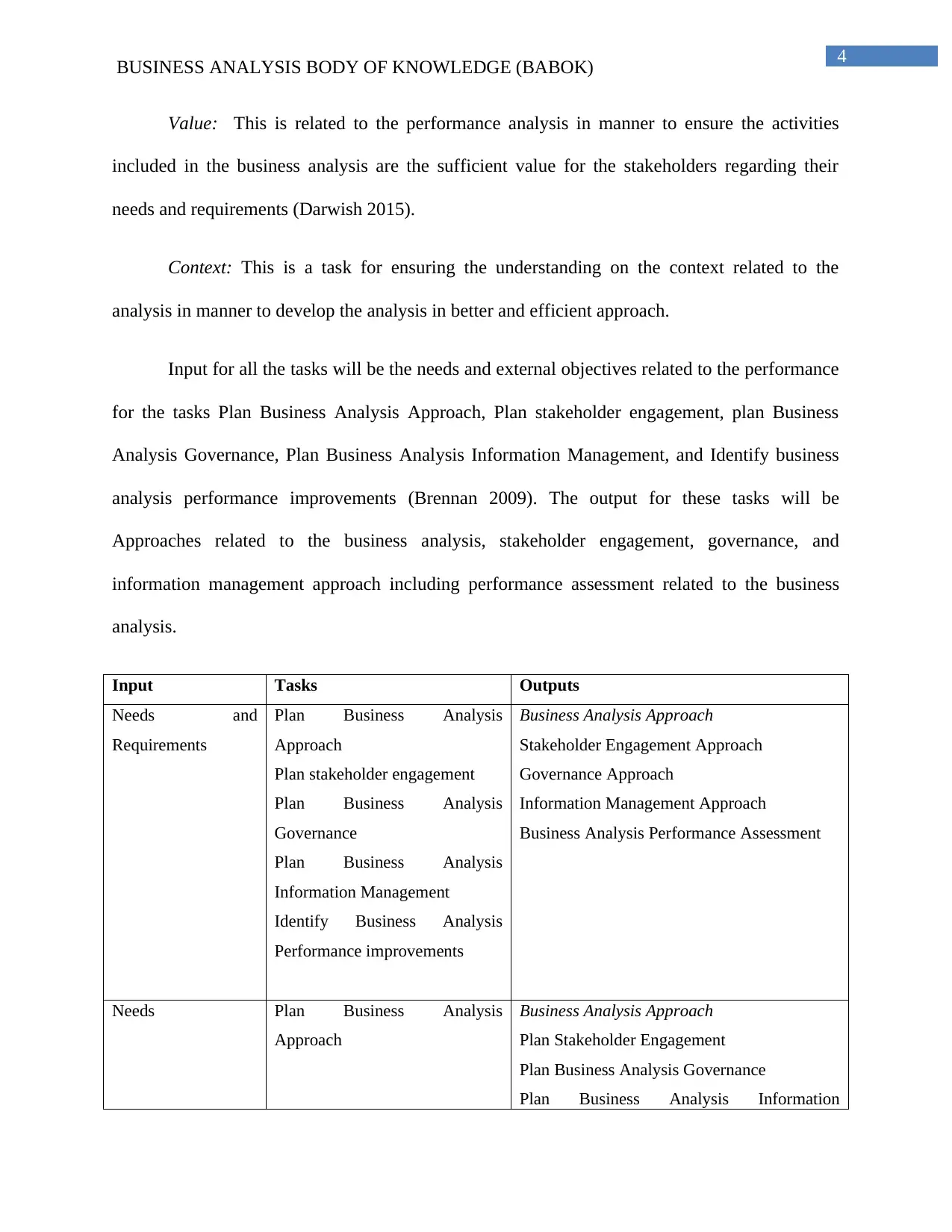
4
BUSINESS ANALYSIS BODY OF KNOWLEDGE (BABOK)
Value: This is related to the performance analysis in manner to ensure the activities
included in the business analysis are the sufficient value for the stakeholders regarding their
needs and requirements (Darwish 2015).
Context: This is a task for ensuring the understanding on the context related to the
analysis in manner to develop the analysis in better and efficient approach.
Input for all the tasks will be the needs and external objectives related to the performance
for the tasks Plan Business Analysis Approach, Plan stakeholder engagement, plan Business
Analysis Governance, Plan Business Analysis Information Management, and Identify business
analysis performance improvements (Brennan 2009). The output for these tasks will be
Approaches related to the business analysis, stakeholder engagement, governance, and
information management approach including performance assessment related to the business
analysis.
Input Tasks Outputs
Needs and
Requirements
Plan Business Analysis
Approach
Plan stakeholder engagement
Plan Business Analysis
Governance
Plan Business Analysis
Information Management
Identify Business Analysis
Performance improvements
Business Analysis Approach
Stakeholder Engagement Approach
Governance Approach
Information Management Approach
Business Analysis Performance Assessment
Needs Plan Business Analysis
Approach
Business Analysis Approach
Plan Stakeholder Engagement
Plan Business Analysis Governance
Plan Business Analysis Information
BUSINESS ANALYSIS BODY OF KNOWLEDGE (BABOK)
Value: This is related to the performance analysis in manner to ensure the activities
included in the business analysis are the sufficient value for the stakeholders regarding their
needs and requirements (Darwish 2015).
Context: This is a task for ensuring the understanding on the context related to the
analysis in manner to develop the analysis in better and efficient approach.
Input for all the tasks will be the needs and external objectives related to the performance
for the tasks Plan Business Analysis Approach, Plan stakeholder engagement, plan Business
Analysis Governance, Plan Business Analysis Information Management, and Identify business
analysis performance improvements (Brennan 2009). The output for these tasks will be
Approaches related to the business analysis, stakeholder engagement, governance, and
information management approach including performance assessment related to the business
analysis.
Input Tasks Outputs
Needs and
Requirements
Plan Business Analysis
Approach
Plan stakeholder engagement
Plan Business Analysis
Governance
Plan Business Analysis
Information Management
Identify Business Analysis
Performance improvements
Business Analysis Approach
Stakeholder Engagement Approach
Governance Approach
Information Management Approach
Business Analysis Performance Assessment
Needs Plan Business Analysis
Approach
Business Analysis Approach
Plan Stakeholder Engagement
Plan Business Analysis Governance
Plan Business Analysis Information
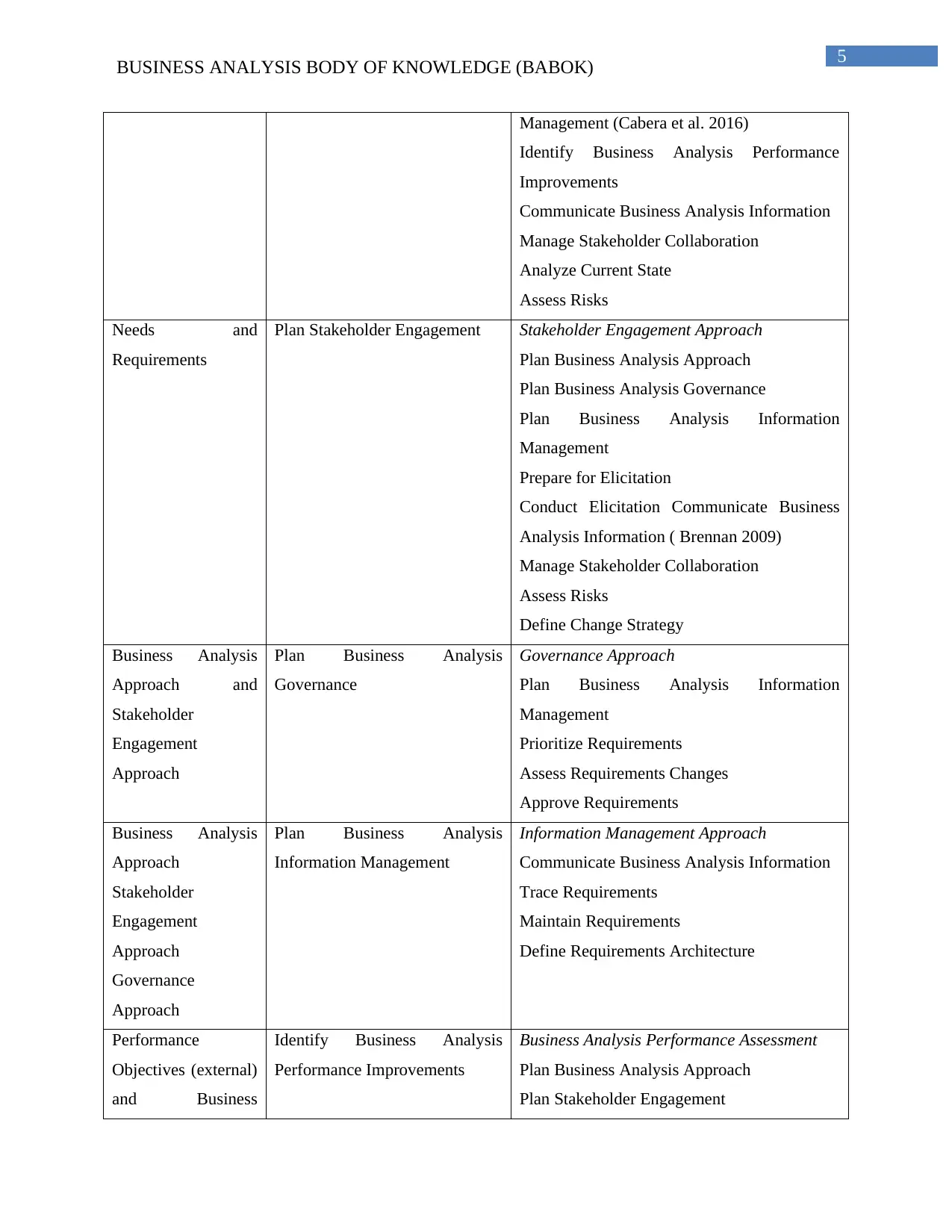
5
BUSINESS ANALYSIS BODY OF KNOWLEDGE (BABOK)
Management (Cabera et al. 2016)
Identify Business Analysis Performance
Improvements
Communicate Business Analysis Information
Manage Stakeholder Collaboration
Analyze Current State
Assess Risks
Needs and
Requirements
Plan Stakeholder Engagement Stakeholder Engagement Approach
Plan Business Analysis Approach
Plan Business Analysis Governance
Plan Business Analysis Information
Management
Prepare for Elicitation
Conduct Elicitation Communicate Business
Analysis Information ( Brennan 2009)
Manage Stakeholder Collaboration
Assess Risks
Define Change Strategy
Business Analysis
Approach and
Stakeholder
Engagement
Approach
Plan Business Analysis
Governance
Governance Approach
Plan Business Analysis Information
Management
Prioritize Requirements
Assess Requirements Changes
Approve Requirements
Business Analysis
Approach
Stakeholder
Engagement
Approach
Governance
Approach
Plan Business Analysis
Information Management
Information Management Approach
Communicate Business Analysis Information
Trace Requirements
Maintain Requirements
Define Requirements Architecture
Performance
Objectives (external)
and Business
Identify Business Analysis
Performance Improvements
Business Analysis Performance Assessment
Plan Business Analysis Approach
Plan Stakeholder Engagement
BUSINESS ANALYSIS BODY OF KNOWLEDGE (BABOK)
Management (Cabera et al. 2016)
Identify Business Analysis Performance
Improvements
Communicate Business Analysis Information
Manage Stakeholder Collaboration
Analyze Current State
Assess Risks
Needs and
Requirements
Plan Stakeholder Engagement Stakeholder Engagement Approach
Plan Business Analysis Approach
Plan Business Analysis Governance
Plan Business Analysis Information
Management
Prepare for Elicitation
Conduct Elicitation Communicate Business
Analysis Information ( Brennan 2009)
Manage Stakeholder Collaboration
Assess Risks
Define Change Strategy
Business Analysis
Approach and
Stakeholder
Engagement
Approach
Plan Business Analysis
Governance
Governance Approach
Plan Business Analysis Information
Management
Prioritize Requirements
Assess Requirements Changes
Approve Requirements
Business Analysis
Approach
Stakeholder
Engagement
Approach
Governance
Approach
Plan Business Analysis
Information Management
Information Management Approach
Communicate Business Analysis Information
Trace Requirements
Maintain Requirements
Define Requirements Architecture
Performance
Objectives (external)
and Business
Identify Business Analysis
Performance Improvements
Business Analysis Performance Assessment
Plan Business Analysis Approach
Plan Stakeholder Engagement
⊘ This is a preview!⊘
Do you want full access?
Subscribe today to unlock all pages.

Trusted by 1+ million students worldwide
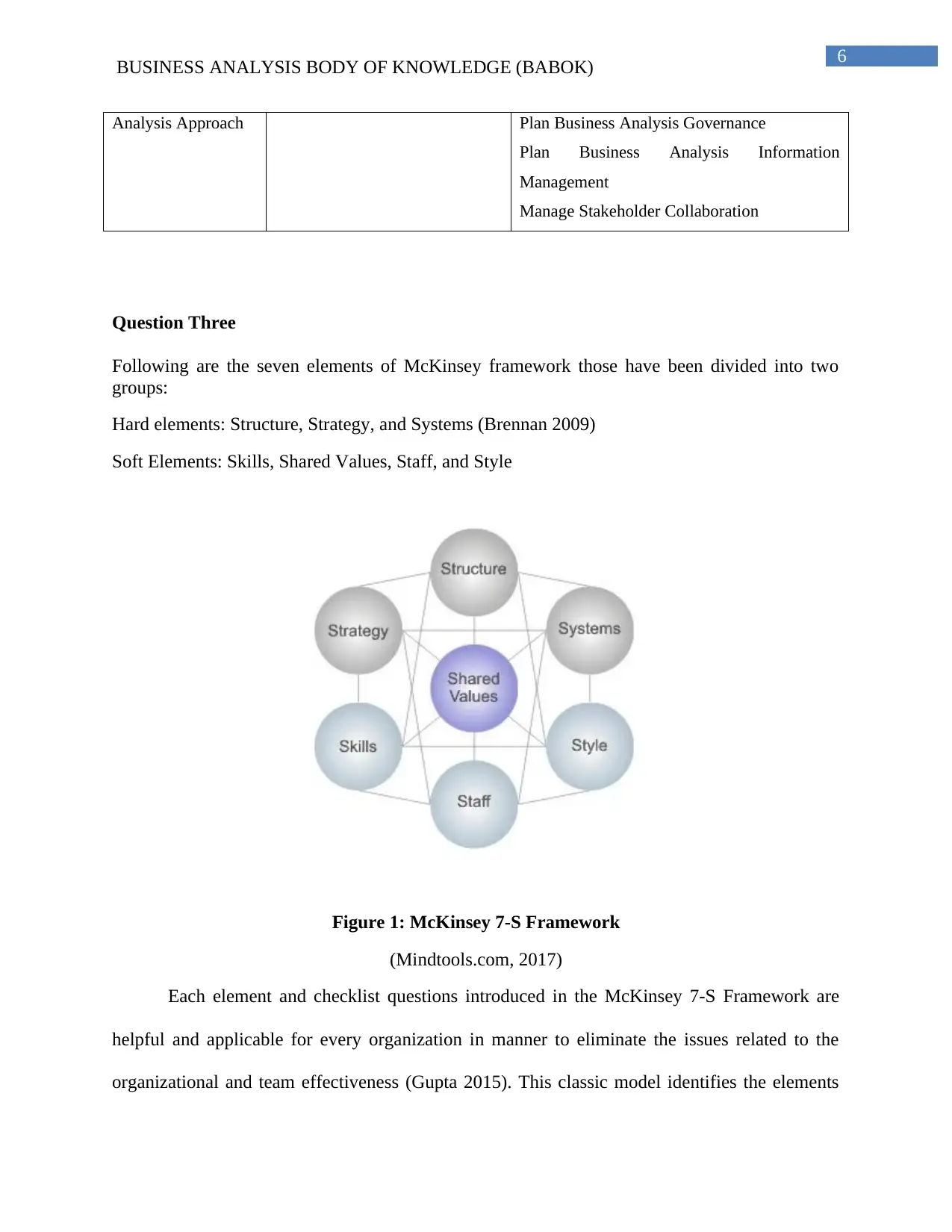
6
BUSINESS ANALYSIS BODY OF KNOWLEDGE (BABOK)
Analysis Approach Plan Business Analysis Governance
Plan Business Analysis Information
Management
Manage Stakeholder Collaboration
Question Three
Following are the seven elements of McKinsey framework those have been divided into two
groups:
Hard elements: Structure, Strategy, and Systems (Brennan 2009)
Soft Elements: Skills, Shared Values, Staff, and Style
Figure 1: McKinsey 7-S Framework
(Mindtools.com, 2017)
Each element and checklist questions introduced in the McKinsey 7-S Framework are
helpful and applicable for every organization in manner to eliminate the issues related to the
organizational and team effectiveness (Gupta 2015). This classic model identifies the elements
BUSINESS ANALYSIS BODY OF KNOWLEDGE (BABOK)
Analysis Approach Plan Business Analysis Governance
Plan Business Analysis Information
Management
Manage Stakeholder Collaboration
Question Three
Following are the seven elements of McKinsey framework those have been divided into two
groups:
Hard elements: Structure, Strategy, and Systems (Brennan 2009)
Soft Elements: Skills, Shared Values, Staff, and Style
Figure 1: McKinsey 7-S Framework
(Mindtools.com, 2017)
Each element and checklist questions introduced in the McKinsey 7-S Framework are
helpful and applicable for every organization in manner to eliminate the issues related to the
organizational and team effectiveness (Gupta 2015). This classic model identifies the elements
Paraphrase This Document
Need a fresh take? Get an instant paraphrase of this document with our AI Paraphraser
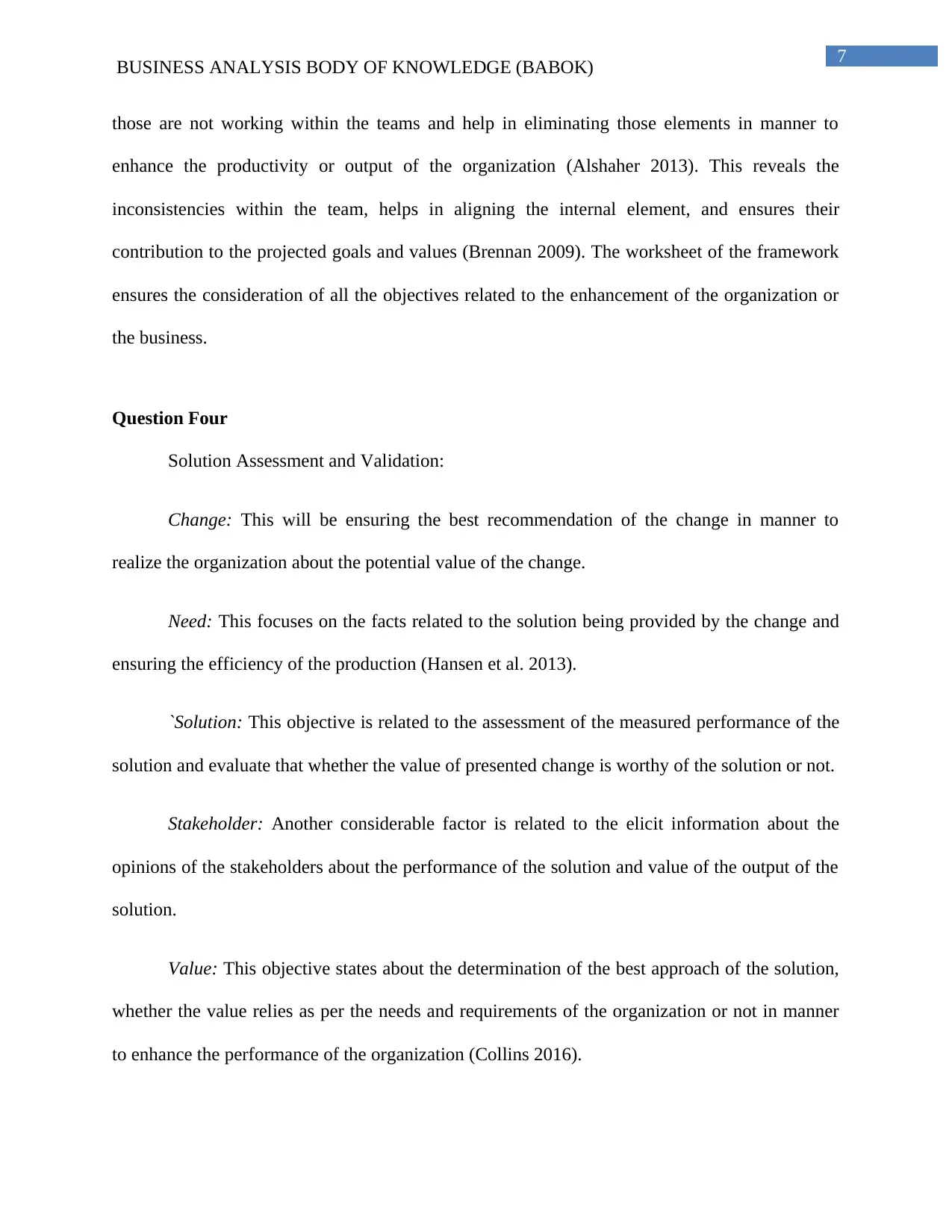
7
BUSINESS ANALYSIS BODY OF KNOWLEDGE (BABOK)
those are not working within the teams and help in eliminating those elements in manner to
enhance the productivity or output of the organization (Alshaher 2013). This reveals the
inconsistencies within the team, helps in aligning the internal element, and ensures their
contribution to the projected goals and values (Brennan 2009). The worksheet of the framework
ensures the consideration of all the objectives related to the enhancement of the organization or
the business.
Question Four
Solution Assessment and Validation:
Change: This will be ensuring the best recommendation of the change in manner to
realize the organization about the potential value of the change.
Need: This focuses on the facts related to the solution being provided by the change and
ensuring the efficiency of the production (Hansen et al. 2013).
`Solution: This objective is related to the assessment of the measured performance of the
solution and evaluate that whether the value of presented change is worthy of the solution or not.
Stakeholder: Another considerable factor is related to the elicit information about the
opinions of the stakeholders about the performance of the solution and value of the output of the
solution.
Value: This objective states about the determination of the best approach of the solution,
whether the value relies as per the needs and requirements of the organization or not in manner
to enhance the performance of the organization (Collins 2016).
BUSINESS ANALYSIS BODY OF KNOWLEDGE (BABOK)
those are not working within the teams and help in eliminating those elements in manner to
enhance the productivity or output of the organization (Alshaher 2013). This reveals the
inconsistencies within the team, helps in aligning the internal element, and ensures their
contribution to the projected goals and values (Brennan 2009). The worksheet of the framework
ensures the consideration of all the objectives related to the enhancement of the organization or
the business.
Question Four
Solution Assessment and Validation:
Change: This will be ensuring the best recommendation of the change in manner to
realize the organization about the potential value of the change.
Need: This focuses on the facts related to the solution being provided by the change and
ensuring the efficiency of the production (Hansen et al. 2013).
`Solution: This objective is related to the assessment of the measured performance of the
solution and evaluate that whether the value of presented change is worthy of the solution or not.
Stakeholder: Another considerable factor is related to the elicit information about the
opinions of the stakeholders about the performance of the solution and value of the output of the
solution.
Value: This objective states about the determination of the best approach of the solution,
whether the value relies as per the needs and requirements of the organization or not in manner
to enhance the performance of the organization (Collins 2016).
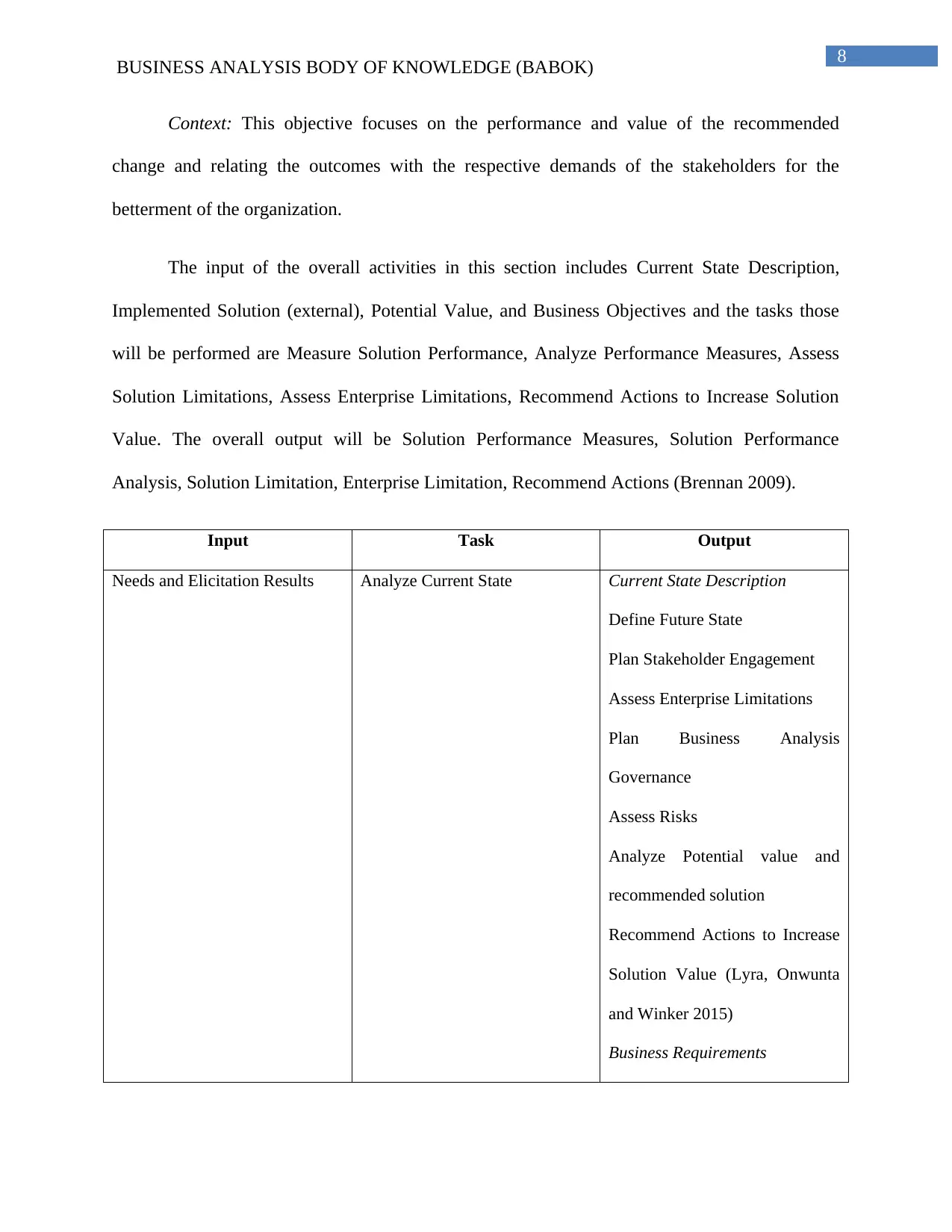
8
BUSINESS ANALYSIS BODY OF KNOWLEDGE (BABOK)
Context: This objective focuses on the performance and value of the recommended
change and relating the outcomes with the respective demands of the stakeholders for the
betterment of the organization.
The input of the overall activities in this section includes Current State Description,
Implemented Solution (external), Potential Value, and Business Objectives and the tasks those
will be performed are Measure Solution Performance, Analyze Performance Measures, Assess
Solution Limitations, Assess Enterprise Limitations, Recommend Actions to Increase Solution
Value. The overall output will be Solution Performance Measures, Solution Performance
Analysis, Solution Limitation, Enterprise Limitation, Recommend Actions (Brennan 2009).
Input Task Output
Needs and Elicitation Results Analyze Current State Current State Description
Define Future State
Plan Stakeholder Engagement
Assess Enterprise Limitations
Plan Business Analysis
Governance
Assess Risks
Analyze Potential value and
recommended solution
Recommend Actions to Increase
Solution Value (Lyra, Onwunta
and Winker 2015)
Business Requirements
BUSINESS ANALYSIS BODY OF KNOWLEDGE (BABOK)
Context: This objective focuses on the performance and value of the recommended
change and relating the outcomes with the respective demands of the stakeholders for the
betterment of the organization.
The input of the overall activities in this section includes Current State Description,
Implemented Solution (external), Potential Value, and Business Objectives and the tasks those
will be performed are Measure Solution Performance, Analyze Performance Measures, Assess
Solution Limitations, Assess Enterprise Limitations, Recommend Actions to Increase Solution
Value. The overall output will be Solution Performance Measures, Solution Performance
Analysis, Solution Limitation, Enterprise Limitation, Recommend Actions (Brennan 2009).
Input Task Output
Needs and Elicitation Results Analyze Current State Current State Description
Define Future State
Plan Stakeholder Engagement
Assess Enterprise Limitations
Plan Business Analysis
Governance
Assess Risks
Analyze Potential value and
recommended solution
Recommend Actions to Increase
Solution Value (Lyra, Onwunta
and Winker 2015)
Business Requirements
⊘ This is a preview!⊘
Do you want full access?
Subscribe today to unlock all pages.

Trusted by 1+ million students worldwide
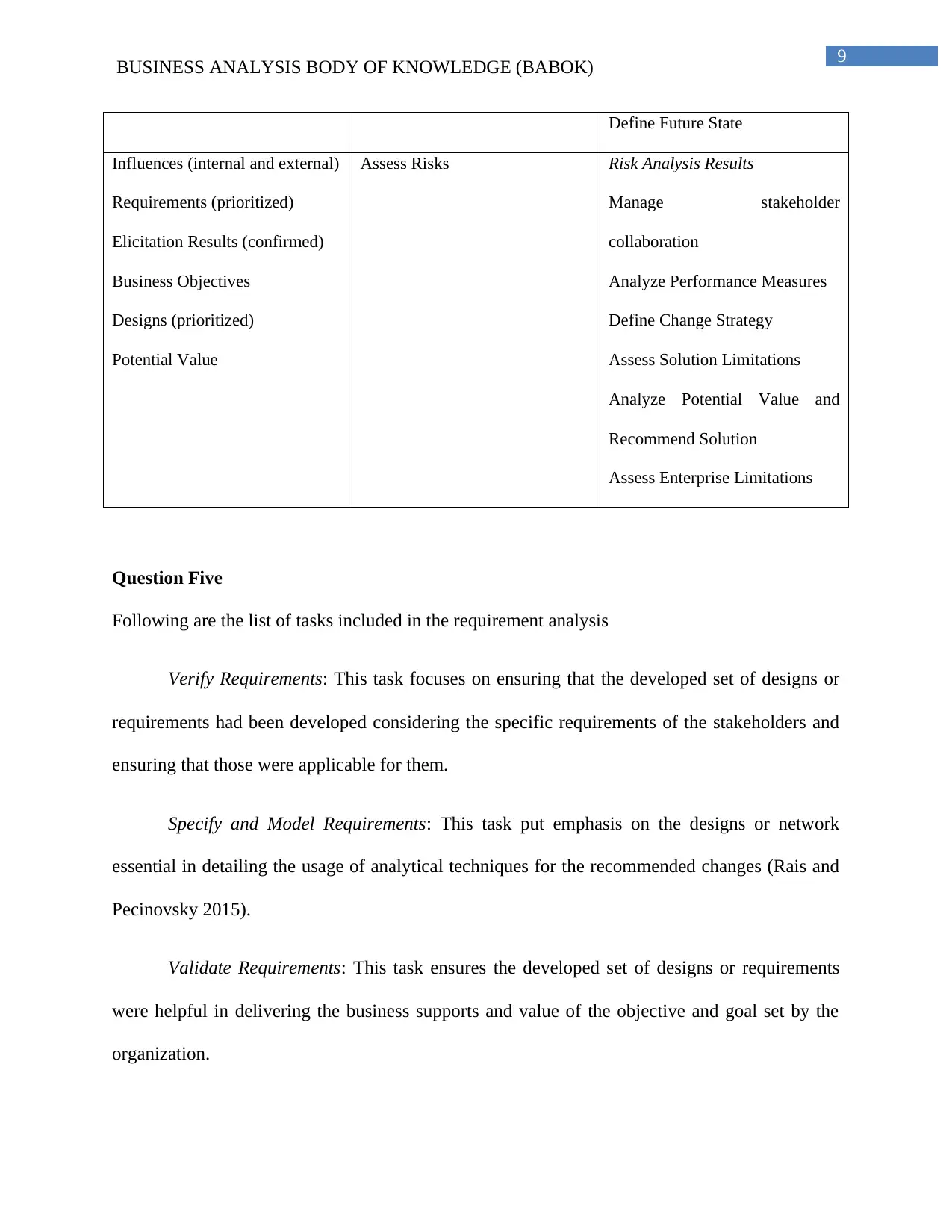
9
BUSINESS ANALYSIS BODY OF KNOWLEDGE (BABOK)
Define Future State
Influences (internal and external)
Requirements (prioritized)
Elicitation Results (confirmed)
Business Objectives
Designs (prioritized)
Potential Value
Assess Risks Risk Analysis Results
Manage stakeholder
collaboration
Analyze Performance Measures
Define Change Strategy
Assess Solution Limitations
Analyze Potential Value and
Recommend Solution
Assess Enterprise Limitations
Question Five
Following are the list of tasks included in the requirement analysis
Verify Requirements: This task focuses on ensuring that the developed set of designs or
requirements had been developed considering the specific requirements of the stakeholders and
ensuring that those were applicable for them.
Specify and Model Requirements: This task put emphasis on the designs or network
essential in detailing the usage of analytical techniques for the recommended changes (Rais and
Pecinovsky 2015).
Validate Requirements: This task ensures the developed set of designs or requirements
were helpful in delivering the business supports and value of the objective and goal set by the
organization.
BUSINESS ANALYSIS BODY OF KNOWLEDGE (BABOK)
Define Future State
Influences (internal and external)
Requirements (prioritized)
Elicitation Results (confirmed)
Business Objectives
Designs (prioritized)
Potential Value
Assess Risks Risk Analysis Results
Manage stakeholder
collaboration
Analyze Performance Measures
Define Change Strategy
Assess Solution Limitations
Analyze Potential Value and
Recommend Solution
Assess Enterprise Limitations
Question Five
Following are the list of tasks included in the requirement analysis
Verify Requirements: This task focuses on ensuring that the developed set of designs or
requirements had been developed considering the specific requirements of the stakeholders and
ensuring that those were applicable for them.
Specify and Model Requirements: This task put emphasis on the designs or network
essential in detailing the usage of analytical techniques for the recommended changes (Rais and
Pecinovsky 2015).
Validate Requirements: This task ensures the developed set of designs or requirements
were helpful in delivering the business supports and value of the objective and goal set by the
organization.
Paraphrase This Document
Need a fresh take? Get an instant paraphrase of this document with our AI Paraphraser
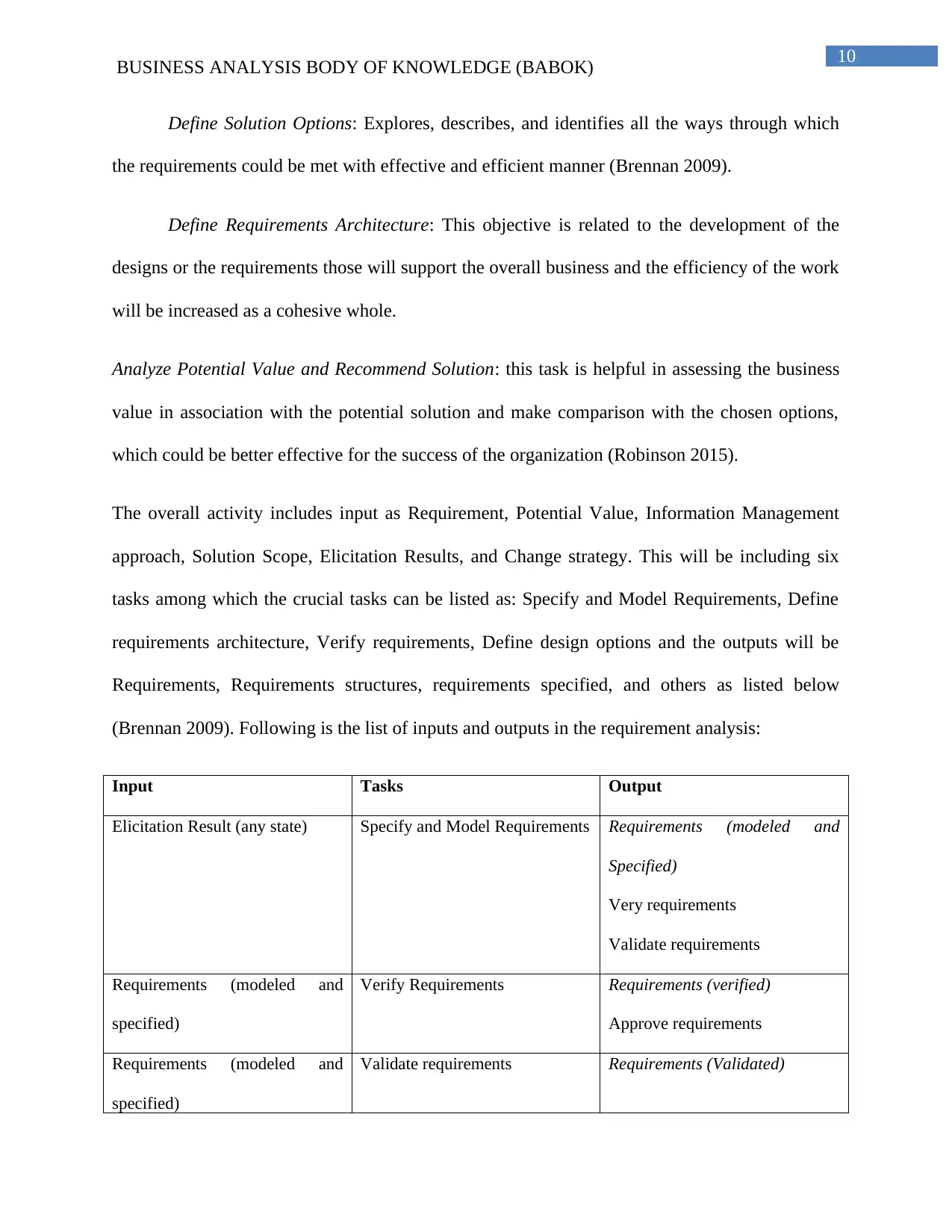
10
BUSINESS ANALYSIS BODY OF KNOWLEDGE (BABOK)
Define Solution Options: Explores, describes, and identifies all the ways through which
the requirements could be met with effective and efficient manner (Brennan 2009).
Define Requirements Architecture: This objective is related to the development of the
designs or the requirements those will support the overall business and the efficiency of the work
will be increased as a cohesive whole.
Analyze Potential Value and Recommend Solution: this task is helpful in assessing the business
value in association with the potential solution and make comparison with the chosen options,
which could be better effective for the success of the organization (Robinson 2015).
The overall activity includes input as Requirement, Potential Value, Information Management
approach, Solution Scope, Elicitation Results, and Change strategy. This will be including six
tasks among which the crucial tasks can be listed as: Specify and Model Requirements, Define
requirements architecture, Verify requirements, Define design options and the outputs will be
Requirements, Requirements structures, requirements specified, and others as listed below
(Brennan 2009). Following is the list of inputs and outputs in the requirement analysis:
Input Tasks Output
Elicitation Result (any state) Specify and Model Requirements Requirements (modeled and
Specified)
Very requirements
Validate requirements
Requirements (modeled and
specified)
Verify Requirements Requirements (verified)
Approve requirements
Requirements (modeled and
specified)
Validate requirements Requirements (Validated)
BUSINESS ANALYSIS BODY OF KNOWLEDGE (BABOK)
Define Solution Options: Explores, describes, and identifies all the ways through which
the requirements could be met with effective and efficient manner (Brennan 2009).
Define Requirements Architecture: This objective is related to the development of the
designs or the requirements those will support the overall business and the efficiency of the work
will be increased as a cohesive whole.
Analyze Potential Value and Recommend Solution: this task is helpful in assessing the business
value in association with the potential solution and make comparison with the chosen options,
which could be better effective for the success of the organization (Robinson 2015).
The overall activity includes input as Requirement, Potential Value, Information Management
approach, Solution Scope, Elicitation Results, and Change strategy. This will be including six
tasks among which the crucial tasks can be listed as: Specify and Model Requirements, Define
requirements architecture, Verify requirements, Define design options and the outputs will be
Requirements, Requirements structures, requirements specified, and others as listed below
(Brennan 2009). Following is the list of inputs and outputs in the requirement analysis:
Input Tasks Output
Elicitation Result (any state) Specify and Model Requirements Requirements (modeled and
Specified)
Very requirements
Validate requirements
Requirements (modeled and
specified)
Verify Requirements Requirements (verified)
Approve requirements
Requirements (modeled and
specified)
Validate requirements Requirements (Validated)

11
BUSINESS ANALYSIS BODY OF KNOWLEDGE (BABOK)
Measure Solution Performance
Define Design Options
Solution Scope, Information
management approach, and
requirements (any state)
Define Requirements
Architecture
Requirements Architecture
Prioritize Requirements, Model
and Specify Requirements,
Assets Requirements Changes,
and Define Design Options
(Ryan 2013)
Question Six
Following is the elicit requirement for the project to build webpage:
User requirements: It describes about the services offered by the system, constraints on
the achievements and the ways in which the system will be providing the requirements. This
should be a less complex and easy to be understood by the persons who are not technically
experienced and without having any background knowledge (Wiegers and Beatty 2013). These
requirements will be defined considering the behaviour and external activities of the system and
will not be based on the system implementation or design.
System Requirements: This will be requiring both functional and non-functional
requirements and should be analysed well by the software engineer before delivering the system.
Functional requirements will be including the expectation of the system, response and reaction
of the system on the application of the webpage, the functions that should not be included and
constraints on the listed objectives (Brennan 2009).
BUSINESS ANALYSIS BODY OF KNOWLEDGE (BABOK)
Measure Solution Performance
Define Design Options
Solution Scope, Information
management approach, and
requirements (any state)
Define Requirements
Architecture
Requirements Architecture
Prioritize Requirements, Model
and Specify Requirements,
Assets Requirements Changes,
and Define Design Options
(Ryan 2013)
Question Six
Following is the elicit requirement for the project to build webpage:
User requirements: It describes about the services offered by the system, constraints on
the achievements and the ways in which the system will be providing the requirements. This
should be a less complex and easy to be understood by the persons who are not technically
experienced and without having any background knowledge (Wiegers and Beatty 2013). These
requirements will be defined considering the behaviour and external activities of the system and
will not be based on the system implementation or design.
System Requirements: This will be requiring both functional and non-functional
requirements and should be analysed well by the software engineer before delivering the system.
Functional requirements will be including the expectation of the system, response and reaction
of the system on the application of the webpage, the functions that should not be included and
constraints on the listed objectives (Brennan 2009).
⊘ This is a preview!⊘
Do you want full access?
Subscribe today to unlock all pages.

Trusted by 1+ million students worldwide
1 out of 15
Related Documents
Your All-in-One AI-Powered Toolkit for Academic Success.
+13062052269
info@desklib.com
Available 24*7 on WhatsApp / Email
![[object Object]](/_next/static/media/star-bottom.7253800d.svg)
Unlock your academic potential
Copyright © 2020–2025 A2Z Services. All Rights Reserved. Developed and managed by ZUCOL.





